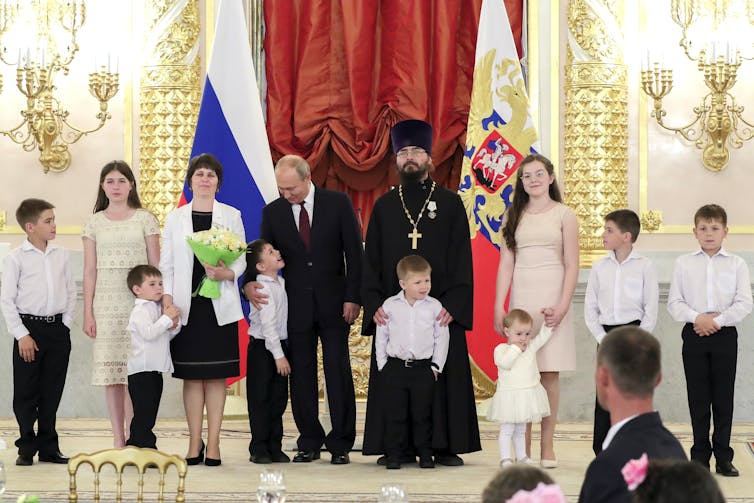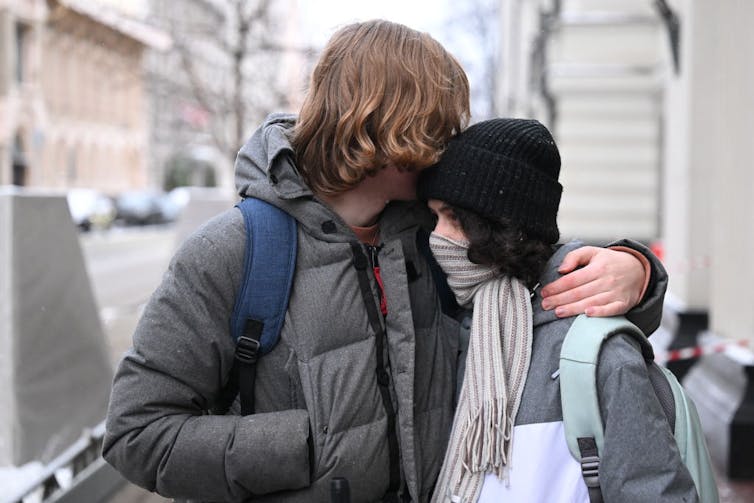Vladimir Putin poses with participants at the Russia Expo in Moscow in front of a sign that says ‘Year of the Family’ on Jan. 23, 2024.
Guzel Garifullina, University of Richmond
As 2025 begins, Russia ends its official “Year of the Family.” But the state has been promoting what it calls “traditional” or “pro-family” values for more than a decade – and looks likely to continue.
“Traditional” values are now central to the idea of “Russian-ness” that the federal government promotes, portraying itself as a defender against many Western societies’ more liberal views on gender, sexuality and reproductive rights.
“Today some countries are cynically destroying the institution of the family, and common, simply normal human values are cynically broken down and replaced by false ones,” Putin said in January 2024, launching the Year of the Family. “Traditional family values drop out of favor in these countries. But we, on the contrary, will preserve, strengthen and pass them on to future generations.”
One of the most recent measures putting traditional values into practice was a November 2024 law introducing fines for what the legislators call “the promotion of the child-free ideology”: any material seen as discouraging Russians from having kids.
An intentionally vague phrase, “traditional values” came to the center of the state ideology after 2012, when Putin came back to office for his third presidential term amid massive protests. Ever since, political and religious leaders at the national level have often voiced their importance – particularly in light of Russia’s declining population. In 2023, Russia’s birth rate was just 1.41 children per woman, the lowest in 17 years – and well below 2.1, deemed the “replacement level” for a stable population.
International attention on the Russian traditional values campaign tends to focus on national leaders’ flashy statements that target voters at home and conservative fans abroad. As a scholar of Russian politics, however, I know federal policies aren’t the full picture. The Kremlin may set the agenda, but regional governments are often where the federal narrative of family values transforms into policies with broader reach.
Russian President Vladimir Putin poses with an Orthodox priest and his family while giving awards to couples with large families on May 30, 2019.
Federal vision
One of the main national-level policies promoting traditional values are one-time government payments for the birth of a child. Named “maternal capital,” the popular benefit was introduced in 2007 for individuals giving birth to, or adopting, their second and subsequent children.
Since 2020, payments have been offered for every child. Current payments for the firstborn amount to about US$6,000, or roughly 10 months of the median monthly salary. The payments are regulated to be primarily used on children’s education or housing.
Federal attempts to restrict abortion, on the other hand, fall short of the rhetoric adopted by church officials and politicians. Widely discussed proposals from the latter include removing abortion care from the free universal health care program or requiring a father’s consent.
Attempts to introduce any sweeping restrictions on abortion have been eventually turned down by federal lawmakers. Under current law, abortion can be performed for any reason until 12 weeks of pregnancy. Women who were raped can access abortion services until 22 weeks, and the procedure is allowed for medical reasons at any point. The only recent federal restriction has been stricter control on drugs used for medical abortions.
Another focus of the federal government’s “values” campaign, and the one receiving the most international attention, is a series of repressive laws targeting LGBTQ+ people. Discussing homosexuality was labeled “propaganda to minors” and became a punishable offense in 2013. Sex-change treatments and changing one’s gender in official documents were outlawed in 2023, and that same year, the Supreme Court declared “the international LGBTQ+ movement” an “extremist organization.”
Youths react outside Russia’s Supreme Court building in Moscow on Nov. 30, 2023, after justices declared the international LGBTQ+ movement an extremist group.
These and related legislative measures have made Russian LGBTQ+ people a target for violence. Many have left the country. But other initiatives against LGBTQ+ rights are mostly symbolic, like the November 2024 law banning adoption to countries where gender transition is legal. Russia has not allowed adoptions to the U.S. since 2012, and just 2.6% of all adoptions were to families overseas in 2021, making that legislative change fairly inconsequential.
Local laws
While the federal government publicizes its anti-LGBTQ measures, regional authorities seem to focus on pro-natalist policies, encouraging childbirth through increasingly inventive measures.
From 2016 to 2018, five regions introduced ad hoc temporary bans on abortions for a symbolically chosen day or week, such as International Children’s Day. In 2023, at least four regions banned abortions in private clinics, and the measure has been recommended in more regions. According to a current estimate, almost 1 in 5 private clinics that used to provide abortions in Russia have stopped doing so.
Since 2023, more than a dozen regions have introduced fines for “encouraging” a woman to have an abortion – leading to concerns among doctors that their support for a patient’s decision could be construed as encouragement. Other regions are discussing such legislation.
One of the most intrusive policies regarding abortion has been implemented in the Belgorod region south of Moscow, where women are often pressured to get approval from a priest and a psychologist before they can get an abortion. While not a legal requirement, it appears to be an informal regional recommendation that public hospitals try to follow.
A banner on a bus stop in St. Petersburg reads: ‘A prospective mother thinks: What do I do now? Will I be able to handle it? Where to find support?’ on Oct. 23, 2023.
Regions don’t rely exclusively on repressive measures, though. As national leaders express concern over Russian women deferring childbirth to prioritize education, some regions have initiatives that encourage earlier pregnancies, specifically among college students. At the moment, at least 11 of the 83 Russian regions have instituted special one-time payments to female college students who have children.
Finally, most regions have their own “maternal capital” payments with various amounts and requirements. For example, in the Novgorod region of Russia’s northwest, parents will receive a regional subsidy of around $3,700 in addition to the federal $6,000 for their first child.
‘Values’ vs. reality
Some of those policy measures are actually at odds with citizens’ preferences, which are often far less “traditional” than the state wants to believe.
Restrictions on LGBTQ+ rights are an exception: By the 2000s, public attitudes were neutral at best and have deteriorated as state propaganda vilifies LGBTQ+ people.
But the Russian population is not, in fact, very conservative when it comes to other issues around sex and family planning. Opinions on premarital sex, access to abortion, divorce and family planning are much more liberal. Almost two-thirds of Russian citizens oppose abortion bans. In a 2019 poll, the average number of children that men and women called ideal was 2.6. The average number of children they themselves expected to have was 1.8 – a far cry from the large family promoted by the state.
Overall, Russian society’s conservatism is much more nuanced and muted than what the state propaganda tries to paint.
What’s more, the country is not homogeneous. Certain areas, like the North Caucasus, show closer adherence to these so-called traditional values in terms of getting married younger and starting families sooner. Most regions, though, are firmly in the category of what demographers call “second demographic transition”: People get married and have children at a later age, use contraception, and have fewer children.
Why the local initiatives?
These attitudes might explain why national authorities’ traditional values policies focus on widely liked measures like child payments, as well as repressive legislation that uses the LGBTQ+ community as a scapegoat. They care about popular support and don’t expect those measures to provoke mass backlash.
Regional governors, on the other hand, more often experiment with potentially unpopular measures to match the national talking points – specifically, discouraging abortions. Regional governors are highly dependent on the Kremlin’s benevolence, and such initiatives may be another way of demonstrating loyalty and compliance. Increasing the birth rate is a federal policy goal consistently communicated to regional authorities and even included in the governors’ formal performance indicators.
The federal government has used regions to roll out unpopular policy initiatives before. During COVID-19, for example, dealing with the pandemic was largely delegated to the regional authorities.
Regional pro-natalist policies further demonstrate the often-overlooked vast differences between parts of Russia. A citizen’s experience of the pressure to act according to “traditional values” may vary depending on which city and region they call home.![]()
Guzel Garifullina, Assistant Professor of Leadership Studies, University of Richmond
This article is republished from The Conversation under a Creative Commons license. Read the original article.

























































